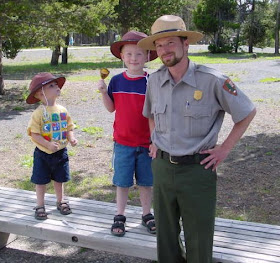
Do you love your national parks? Are you drawn to the beauty
and history they hold within their boundaries? So are we!
Your national parks are one of the best teaching tools
available for learning inside and outside the classroom, and over the next
several months Two Geeky Teachers will dive into some of the many print and
digital resources that are available from the National Park Service through
this blog. To launch this discovery series we start with the Junior Ranger
Program (which evidenced by the photo below is not just for students anymore!) We have been involved with them from coast to coast and in between!
If you are lucky enough to visit a park you can get these patches and badges!
Or you can complete some programs online and still receive a
Junior Ranger pin via mail or a Web Ranger patch.
Here are five ways you can use the Junior Ranger program in the classroom along with some highlights from the program included in the links below. Regardless of being in a park—teachers will find the information contained in the Junior Ranger program books a huge score for teaching history, science, geography, and other subjects. We love our national parks…we are betting your students will too. Here we go… Ready? Enjoy!
Five Ways to Use the Junior Ranger Program in the Classroom
5) Engage students in
using the Junior Ranger program as a means to research an important location,
which holds information on a topic of study and could have been a turning point
in the course of American History.
Did You Know About the
Junior Ranger Program At: Fort Sumter National Monument?
Tech Connection: Use
a technology tool such as SpicyNodes (www.spicynodes.org) to help students
organize their research around an essential question(s).
4) Use the Junior
Ranger program to research a historical figure and bring to light little known
information on that person, or sites that are unknown or out of the limelight,
which could give more information about his/her life.
Did You Know About the
Junior Ranger Program At: Abraham Lincoln Birthplace? http://www.nps.gov/abli/forkids/beajuniorranger.htm
Tech Connection:
Use the information from the Junior Ranger Program to create a Blabberize (www.blabberize.com) biography of young Abe
Lincoln
3) Use the Junior Ranger
Program as a means to explore literature and place in their humanities studies!
The National Park Service has many locations that highlight significant authors
and their works. Broaden your social studies content to humanities content by
including literature and written works in your online or personal quest for
understanding America.
Did You Know About the
Junior Ranger Program At: The Edgar Allen Poe National Historic Site? http://www.nps.gov/edal/forkids/beajuniorranger.htm
Tech Connection:
Use the information from the Junior Ranger Program to create a found poetry
poster presentation in Glogster (http://edu.glogster.com/)
2) Use the Junior
Ranger Program to explore science and the environment, and create an
appreciation for our natural landscapes. Connect social studies and science
together through an educational lesson on a scientist.
Did You Know About the
Junior Ranger Program At: The Thomas Edison National Historic Site? http://www.nps.gov/edis/forkids/beajuniorranger.htm
Tech Connection:
Use the information from the Junior Ranger Program and connect it to primary
sources from your national library, the Library of Congress. The Library of
Congress houses Edison films and recordings, drawings, and papers from the
famous scientist. Use clips from an Edison film to create a presentation on a
famous event or person in iMovie to share with your class.
1) Encourage students
and their families to get outdoors and explore their world together. Learning
together, sharing together, and enjoying our National Parks can be a family
event! You are never too old to be a Junior Ranger, and you can always start
early too even if it is just wearing a “flat hat” and knowing that our park
rangers are pretty special! It is these rangers that help make our National Parks a special place to visit.
In honor of our First National Park we will embarrass the geeks in our house
with a picture of their very first Junior Ranger badge at Old Faithful
Lodge/Visitors Center in Yellowstone (And yes this is the same kiddo in the picture at Mount Rainier below. Imagine that-- 12 years of Junior Rangers and 35 patches and pins later...) :
Did You Know About the
Junior Ranger Program At: Yellowstone National Park
Tech Connection:
Use the information from the Junior Ranger program to help differentiate
content in the classroom setting though activities at different levels of
complexity. Use a tool such as Animoto (http://animoto.com/)
or Prezi (http://prezi.com/)
to have students
create a collaborative presentation on what they have learned to share with an
authentic audience.
And to prove that we have used them from coast to coast heres the photo evidence as our geeks would call it!
And to prove that we have used them from coast to coast heres the photo evidence as our geeks would call it!
 |
| Fort Clatsop- Lewis and Clark National Historic Park |
 |
| Fort Clatsop- Lewis and Clark National Historic Park |
 |
| Ellis Island National Historic Park |
 |
| Yellowstone National Park |
 |
| Minuteman National Historical Park |
 |
| Mount Rainier National Park |
 |
| Yellowstone National Park |



No comments:
Post a Comment